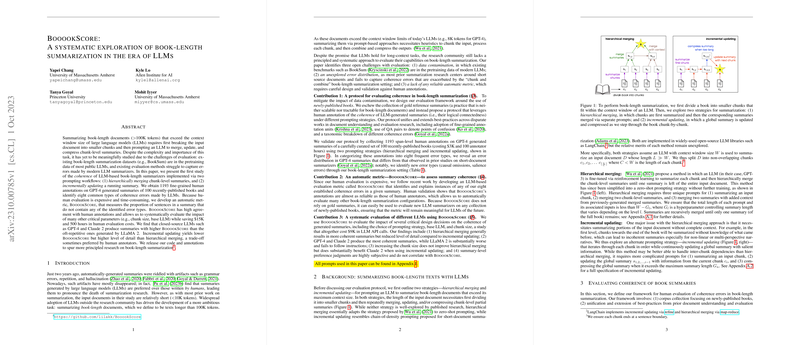BooookScore: A Systematic Exploration of Book-Length Summarization in the Era of LLMs
The emergence of LLMs has brought newfound capabilities to the domain of document summarization, particularly with the complex task of summarizing book-length texts. The paper "BooookScore: A systematic exploration of book-length summarization in the era of LLMs" by Yapei Chang, Kyle Lo, Tanya Goyal, and Mohit Iyyer provides an in-depth examination of this task, addressing the unique challenges posed by the summarization of documents exceeding 100K tokens.
Overview and Contributions
The primary challenge in book-length summarization arises from the fact that these documents far exceed the typical context window size of LLMs, necessitating the division of the text into manageable chunks. The authors explore two distinct prompting workflows for summarizing these chunks: hierarchical merging and incremental updating. Hierarchical merging involves summarizing chunks individually and then recursively merging these summaries, while incremental updating keeps a running summary, updating it with each new chunk.
The paper makes significant contributions across three main areas:
- Coherence Evaluation Protocol:
- The authors construct a protocol for evaluating the coherence of LLM-generated book summaries. Recognizing the constraints of existing benchmarks and the expense of human evaluation, they curate a dataset of 100 recently-published books, avoiding pre-training data contamination.
- Human annotators provide fine-grained evaluations, identifying coherence errors such as entity omissions, event omissions, causal omissions, discontinuities, salience issues, language issues, inconsistencies, and duplications. These errors highlight how modern LLMs handle the complexities of book-length summarization tasks.
- Automatic Metric - BooookScore:
- To overcome the cost-intensive nature of human evaluations, the authors develop BooookScore, an automatic metric leveraging LLMs like GPT-4 to assess summary coherence. This metric evaluates the proportion of sentences in a summary that do not exhibit any of the predefined coherence errors. BooookScore shows high agreement with human annotations and offers a scalable approach to evaluating the impact of various summarization parameters.
- This metric allows for systematic evaluation across numerous configurations, effectively reducing costs and effort, saving approximately $15K USD and 500 annotator hours.
- Systematic Evaluation of LLM Performance:
- The paper details comprehensive evaluations of different LLMs (e.g., GPT-4, GPT-3.5-Turbo, Claude 2, Mixtral-8x7B, and LLaMA-2-7B-Inst) using BooookScore. Notably, closed-source models such as GPT-4 and Claude 2 generate more coherent summaries compared to open-source models.
- The authors find that hierarchical merging generally yields more coherent summaries than incremental updating, though the latter provides a higher level of detail—a trade-off sometimes favored by human annotators.
Implications and Future Directions
The findings in this paper have several practical and theoretical implications:
- Practical Implications:
- Closed-source LLMs' superior performance in generating coherent summaries suggests a continued role for proprietary models in high-stakes applications. However, the promising results of open-source models like Mixtral indicate potential for future improvements, particularly as these models continue to evolve.
- The paper’s methodology and insights into chunk size and chunking strategies can inform the development of more effective summarization tools for long documents, which is particularly relevant for domains requiring exhaustive document review, such as law and academia.
- Theoretical Implications:
- The identified coherence error types and their distributions further our understanding of where and why LLMs struggle with long-form content, offering a foundation for refining model architectures and training methods.
- BooookScore’s effectiveness in automating coherence evaluation paves the way for similar metrics in related tasks, expanding the toolkit for LLM evaluation beyond traditional benchmarks.
- Future Developments in AI:
- Incorporating longer context windows into LLM architectures could mitigate some of the current limitations, facilitating more coherent handling of book-length texts without extensive chunking.
- Further research might explore hybrid models that integrate hierarchical and incremental strategies, potentially combining their strengths.
- Enhancing the robustness of automatic evaluators like BooookScore by integrating diverse LLMs or even multi-task evaluators could yield even more reliable metrics, fostering advancements in summarization technology.
The authors provide comprehensive resources, including code and annotations, to support ongoing research in book-length summarization. The continued development of such methodologies will likely result in increasingly effective and efficient tools, improving the usability of LLMs in handling extensive documents and complex narratives.
